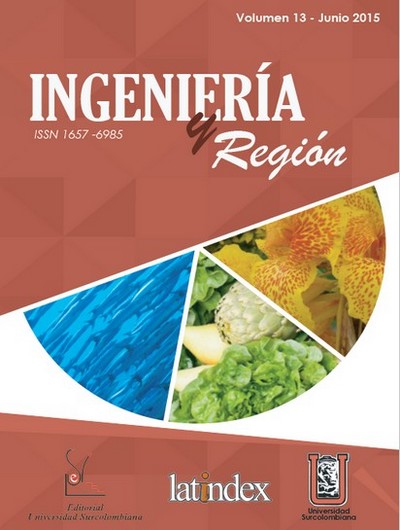Software de ingeniería especializado en el diseño y simulación de plantas de tratamiento de agua residual: revisión
##plugins.themes.bootstrap3.article.main##
Este documento presenta una revisión sobre los programas más utilizados para la simulación, diseño y control de plantas de tratamiento de agua residual. Se plantea la posibilidad de utilizar este tipo de herramientas para investigación, ambientes profesionales y de docencia. Este documento recopila el software más utilizado, teniendo en cuenta que estas herramientas permiten mejorar el rendimiento, control y la optimización de las plantas de tratamiento de agua residual.
Descargas
##plugins.themes.bootstrap3.article.details##
Alex, J., 2009. Neue Entwicklungen im Abwasser simulations system SIMBA - Lagrange basierte Gewässergüte simulation., ifak-Institutskolloquium.
Anderson JS, Kim H, McAvoy TJ, Hao OJ., 2000. Control of an alternating aerobic-anoxic activated sludge system - Part 1: Development of a linearizationbased modeling approach. Control Eng. Pract., 8:271-278.
Ayesa Iturrate, E., Gran Gumbao, P., Salterain Ezquerra, A., & Irizar Picón, I., 2007. Estrategias avanzadas de control automático para la eliminación de N en EDAR de Galindo. Tecnología del Agua, (284), 60-68.
Batstone D.J., Keller J., Angelidaki I., Kalyuzhnyi S.V., Pavlostathis S.G., Rozzi A., Sanders W. T. M., Siegrist H. and Vavilin V.A., 2002. Anaerobic Digestion Model No. 1. Scientific and Technical Report No. 13, IWA Publishing, London.
Baquero, A., Lara, J., Romero, C., Vargas, L., & Martelo, J., 2014. Estudio de la tratabilidad del agua residual afluente a las futuras plantas de tratamientos salitre y canoas (tratamiento secundario) de la ciudad de Bogotá en plantas piloto con el sistema de lodos activados. Pontificia Universidad Javeriana.
Contreras Barrera, J. I., 2010. Modelación del sedimentador secundario en planta de lodos activados.
Copp JB., 2002. Experience with guidelines for waster characterization in The Netherlands. Technical report, The COST Simulation Benchmark: Description and Simulator Manual. Office for Official Publications of the European Community, ISBN 92-894-1658-0, (Luxembourg).
Chan and Yue-ping., 2003. Simulation and analysis of biological wastewater treatment processes using GPS-X. The University of Hong Kong (Pokfulam, Hong Kong). Master of Science in Environmental Management.
Dircks K, Beun JJ, Van Loosdrecht MCM, Heijnen JJ, Henze M., 2001. Glycogen metabolism in aerobic mixed cultures. Biotechnol. BioEng., 73(2): 85-94.
Dold P, Ekama GA, Marais GVR., 1980. A general model for the activated sludge process. Progress in Water Technol., 12(6): 47-77.
Durán Pinzón, F., 2014. Modelación matemática del tratamiento anaerobio de aguas residuales urbanas incluyendo las bacterias sulfatorreductoras. Aplicación a un biorreactor anaerobio de membranas (Doctoral dissertation).
Erbe, V., Risholt, L. P., Schilling, W., & Londong, J., 2002. Integrated modelling for analysis and optimization of wastewater systems–the Odenthal case. Urban Water, 4(1), 63-71.
Eriksson L, Hagbert P, Johansson E, R´annar S, Whelehan O, °Astrom A, Lindgren T., 2001. Multivariate process monitoring of a newsprint mill. Application to modeling and predicting COD load resulting from deinking of recycled paper. J. Chemom., 15: 337-352.
Fang, F., Ni, B., Li, W., Sheng, G., & Yu, H., 2011. A simulation-based integrated approach to optimize the biological nutrient removal process in a full-scale wastewater treatment plant. Chemical Engineering Journal, 174(2), 635-643.
Ferrer J., Seco A., Serralta J., Ribes J., Manga J., Asensi E., Morenilla J.J. y Llavador F., 2008. DESASS: a software tool for designing, simulating and optimising WWTPs. Environmental Modelling and Software, 23, 19-26.
Ferrer J., Morenilla J.J., Bouzas A. and Garcia-Usach F., 2004. Calibration and simulation of two large wastewater treatment plants operated for nutrient removal. This issue.
Ferrer J., Seco A., 2006. “DESASS 1.1 ®: Manual de usuario”; Universidad Politécnica de Valencia.
Ferrer J., Seco A., Ribes J., Serralta J., 2004. Biological Nutrient Removal Model No.1 (BNRM1); Universidad Politécnica de Valencia.
García Landero, I., 2012. Diseño de la Estación Depuradora de Aguas Residuales» EDAR Norte de Sevilla» mediante el software DESASS (Doctoral dissertation). 69 Software de ingeniería especializado en el diseño y simulación... / Sánchez Ramírez & Cols. Revista Ingeniería y Región. 2015;13(1):57-71
Gujer W. and Henze M., 1991. Activated Sludge Modelling and Simulation, Wat. Sci. Tech., 24, Kyoto, pp 1011-1023.
Gujer W., Larsen T.A., 1995. The Implementation of Biokinetics and Conservation Principles in ASIM, Wat. Sci. Tech, 31, No. 2, 257-266.
Gernaey KV, Van Loosdrecht MCM, Henze M, Lind M, Jorgensen SB., 2004. Activated sludge wastewater treatment plant modeling and simulation: state of the art. Environ. Model. Software, 19: 763-783.
Gustaf Olsson and bob newell., 2000. Wastewater treatment systems: modeling, diagnosis and control, IWA publishing.
Grau-Gumbau, P., 2011. Nueva Metodología de Modelado Matemático Integral de las EDAR.
Handbuch, ifak e.V. Magdeburg., 2001. SIMBA 4.0 Simulation der biologischen Abwasserreinigung.
Hinken, L., Huber, M., Weichgrebe, D., & Rosenwinkel, K. H., 2014. Modified ADM1 for modelling an UASB reactor laboratory plant treating starch wastewater and synthetic substrate load tests. Water research, 64, 82-93.
Henry M., 2003. Method for wastewater characterization in activated sludge modelin. Water environment research foundation.
Henze M, Grady Jr CPL, Gujer W, Marais GVR, Matsuo T., 1987. Activated Sludge Model No.1. Technical report, IWAPRC Scientific and Technical Report No.1 London (Great Britain).
Henze M, Gujer W, Mino T, Matsuo T, Wentzel MC.,1995. Activated Sludge Model No.2. Technical report, IWAPRC Scientific and Technical Report No. 2 London (Great Britain).
Henze, M., Gujer, W., Mino, T., and van Loosdrecht, M., 2000. Activated Sludge Models ASM1, ASM2, ASM2D and ASM3. London, UK: IWA Publishing.
Henze M., W. Gujer., T. Mino., and van Loosdrecht., 2000. Activated Sludge Models ASM1, ASM2, ASM2d and ASM3, IWA, Sci. and Tech. Report No. 9. IWA Publishing, London (2000).
Henze M., W. Gujer., T. Mino., T. Matsuo., M.C. Wenzel., and C.V.R. Marais., 1999. Activated sludge model no. 2d Water Sci. Technol., 39 (1) (1999), pp. 165-182
Henze, M., 2008. Biological wastewater treatment: principles, modelling and design. IWA publishing.
Iturrate, E. A., & Urcola, A. L., 2005. Optimización del diseño, operación y control de las EDAR utilizando modelos matemáticos y herramientas de simulación. Tecnología del agua, (266), 74-79.
Liwarska-Bizukojc, E., & Biernacki, R., 2010. Identification of the most sensitive parameters in the activated sludge model implemented in BioWin software. Bioresource technology, 101(19), 7278-7285.
Martínez, J. J. M., Bonora, I. B., Basiero, J. A., Fajardo, V., Zorrilla, F., Lloret, R. M., & Granell, P.,2008. Utilización de herramientas de simulación para definir la estrategia óptima de implementación del proceso de eliminación biológica de nitrógeno en la EDAR de Ontinyent. Tecnología del agua, 28(299), 53-61.
Morenilla, J. J., Bernácer, I., Lloret, R. M., Basiero, J. A., Zorrilla, F., Fajardo, V & Granell, P., 2008. Utilización de herramientas de simulación para definir la estrategia óptima de implementación del proceso de eliminación biológica de nitrógeno en la EDAR de Ontinyent. Tecnología del Agua, (299), 53-61.
Mhlanga, F. T., Brouckaert, C. J., Foxon, K. M., Fennemore, C., Mzulwini, D., & Buckley, C. A., 2009. Simulation of a wastewater treatment plant receiving industrial effluents. Water SA, 35(4), 447-454.
Metcalf y Eddy., 1991. Wastewater Engineering Treatment. Disposal, Reuse. 3a. Edition. USA. (Ingeniería en el tratamiento de aguas residuales. Disposición y reuso. Mc Graw-Hill International Editions. 3a. Edición. E.U.A.).
Mike M., Jamie G., Jason B., Chris W., Theresa B., and Don Howard., 2009. BioWin Modeling of a Three Reactor IFAS System. Proceedings of the Water Environment Federation 82ND Annual Technical Exhibition & Conference, Orlando, FL, USA, October 10-14.
Nasr, M. S., Moustafa, M. A., Seif, H. A., & El Kobrosy, G., 2011. Modelling and simulation of 70 Revista Ingeniería y Región. 2015;13(1):57-71 Software de ingeniería especializado en el diseño y simulación... / Sánchez Ramírez & Cols. German BIOGEST/EL-AGAMY wastewater treatment plants–Egypt using GPS-X simulator. Alexandria Engineering Journal, 50(4), 351-357.
Olsson, G., B. Newell., 1999. Wastewater Treatment Systems: Modelling, Diagnosis and ControL, IWA.
Palma-Acosta, M. J., & Manga Certain, J., 2011. Simulación de un sistema de fangos activados en discontinuo (SBR) para el tratamiento de aguas residuales con altos contenidos de nitrógeno.- Revista Científica Ingeniería y Desarrollo, 18(18), 61-71.
Pedersen, J., 1992. Controlling activated sludge process using EFOR. Water Science & Technology, 26(3-4), 783-790.
Pons, M. N., Spanjers, H., & Jeppsson, U., 1999. Towards a benchmark for evaluating control strategies in wastewater treatment plants by simulation. Computers & Chemical Engineering, 23, S403-S406.
Portillo, N. P., Melero, M. P. O., Campo, E. R., & Izaguirre, J. P., 2012. Modelización y simulación de la EDAR de La Cartuja en Zaragoza, mediante el programa Bio Win 3.0. Tecnología del agua, 32(337), 42-49.
Reichert P., 1998a. AQUASIM 2.0 - User Manual, computer program for the identification and simulation of aquatic systems, Swiss Federal Institute for Environmental Science and Technology (EAWAG), Switzerland. ISBN 3-906484-16-5.
Reichert P., 1998b. AQUASIM 2.0 -Tutorial, computer program for the identification and simulation of aquatic systems, Swiss Federal Institute for Environmental Science and Technology (EAWAG), Switzerland. ISBN 3-906484-17-3.
Rey Gosálbez, H., Gracia Igelmo, M., Larrea Urcola, M. A., Morenilla Martínez, J. J., Bernácer Bonora, I., & Santos Asensi, J. M., 2007. Optimización de la operación de la EDAR de Guarmar del Segura mediante la utilización de herramientas de simulación. Tecnología del Agua, (284), 38-46.
Ribes J., Ferrer J., Bouzas A. and Seco A., 2002. Modelling of an activated primary settling tank including the fermentation process and VFA elutriation. Environ. Technol., 23, 1147-1156.
Rivera-Salvador, V., Aranda-Barradas, J. S., Espinosa-Solares, T., Robles-Martínez, F., & Toledo, J. U.,2009. El Modelo de Digestión Anaeróbica IWA-ADM1: una revisión de su evolución. Ingeniería Agrícola y Biosistemas, 1(2), 109-118.
Roeleveld PJ, Van Loosdrecht MCM., 2002. Experience with guidelines for waster characterization in The Netherlands. Water Sci. Technol., 45(6):77-87.
Sarkar, U., Dasgupta, D., Bhattacharya, T., Pal, S., & Chakroborty, T., 2010. Dynamic simulation of activated sludge based wastewater treatment processes: Case studies with Titagarh Sewage Treatment Plant, India.Desalination, 252(1), 120-126.
Seco. A., Ribes. J.,Serralta. J., and Ferrer. J., 2004. Biological nutrient removal model No.1 (BNRM1). Water Science & Technology. 50(6), 69-70.
Serralta J., Ferrer J., Borras L. and Seco A., 2003. A chemical model to calculate the pH in biological processes. Submitted to Water Research.
Smolders GJF, Klop JM, van Loosdrecht MCM, Heijnen JJ., 1995. Metabolic model of the biological phosphorus removal process: part I. Effect of the sludge retention time. Biotechnol. BioEng. 48: 222-233.
Sochacki, A., Knodel, J., Geißen, S. U., Zambarda, V., Miksch, K., & Bertanza, G., 2009. Modelling and simulation of a municipal WWTP with limited operational data. In Proceedings of a Polish-Swedish-Ukrainian Seminar (pp. 23-25).
Stokes, A. J., West, J. R., Forster, C. F., Kruger, R. C. A., De Bel, M., & Davies, W. J., 1997a. Improvements to a stoat model of a full scale wastewater treatment works through the use of detailed mechanistic studies. Water science and technology, 36(5), 277-284.
Stokes, A. J., West, J. R., Forster, C. F., Kruger, R. C. A., De Bel, M., & Davies, W. J.,1997b. Improvements to a STOAT model of a full scale wastewater treatment works through the use of detailed mechanistic studies.Water science and technology, 36(5), 277-284.
Stokes, A. J., West, J. R., Forster, C. F., & Davies, W. J., 2000. Understanding some of the differences 71 Software de ingeniería especializado en el diseño y simulación... / Sánchez Ramírez & Cols. Revista Ingeniería y Región. 2015;13(1):57-71 between the COD-and BOD-based models offered in STOAT. Water Research, 34(4), 1296-1306.
Takács, I., Patry, G.G. and Nolasco, D., 1991 A dynamic model of the clarification-thickening process. Wat. Res., 25(10), 1263-1271.
Van Loosdrecht M.C.M y Henze M., 1999. Maintenance, endogeneous respiration, lysis, decay and predation. Wat. Sci. Tech. 39 (1), 107-117.
Vitanza, R., Colussi, I., Cortesi, A., & Gallo, V., 2015. Implementing a respirometry-based model into BioWin software to simulate wastewater treatment plant operations. Journal of Water Process Engineering.
Water Treatment Hanbook, 1991. (Manual de Tratamiento de Agua. Degremont 6a. Edition Vol. I y II. E.U.A.).


















